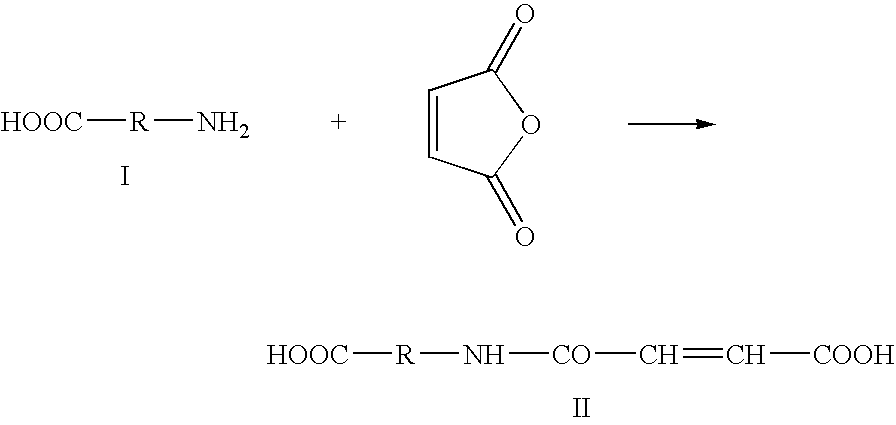Modified biodegradable polymers, preparation and use thereof for making biomaterials and dressings
a biodegradable polymer and polymer technology, applied in the field of new chemical processes in aqueous medium for modifying biodegradable polymers, can solve the problems of inability of epidermis, significant loss of blood, and use of epidermis that cause important cellular toxicity, and achieve the effect of avoiding the parasitic cross-linking reaction of these polymers
- Summary
- Abstract
- Description
- Claims
- Application Information
AI Technical Summary
Benefits of technology
Problems solved by technology
Method used
Image
Examples
Embodiment Construction
[0144]As mentioned above, the present invention is directed to a process for preparing a modified biodegradable polymer. The process generally comprises a first step (a) of a reaction in aqueous medium between an amino acid, a peptide or a polypeptide and maleic anhydride (also called but-2-eneoic anhydride) to form a vinyl-carboxylic acid. In a second step (b), a reaction in aqueous medium takes place between the vinyl-carboxylic acid of step (a) and a biodegradable polymer. For second step (b) to take place, it is necessary that the biodegradable polymer used has at least one primary amino function which reacts with the double bond of the vinyl-carboxylic acid. The biodegradable polymer is obtained at the end of the second step.
4.1. Synthesis of the Vinyl-Carboxylic Acid Compound
[0145]From a schematic point of view, the general chemical reaction which takes place in step (a) of the process according to the invention can be represented by the following:
in which R represents an amin...
PUM
| Property | Measurement | Unit |
|---|---|---|
| Fraction | aaaaa | aaaaa |
| Fraction | aaaaa | aaaaa |
| Fraction | aaaaa | aaaaa |
Abstract
Description
Claims
Application Information
 Login to View More
Login to View More - R&D
- Intellectual Property
- Life Sciences
- Materials
- Tech Scout
- Unparalleled Data Quality
- Higher Quality Content
- 60% Fewer Hallucinations
Browse by: Latest US Patents, China's latest patents, Technical Efficacy Thesaurus, Application Domain, Technology Topic, Popular Technical Reports.
© 2025 PatSnap. All rights reserved.Legal|Privacy policy|Modern Slavery Act Transparency Statement|Sitemap|About US| Contact US: help@patsnap.com

